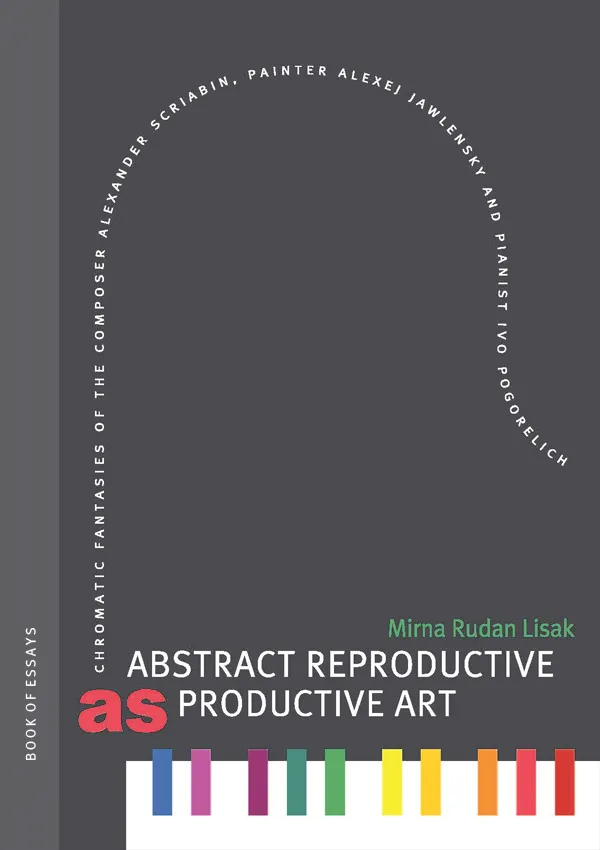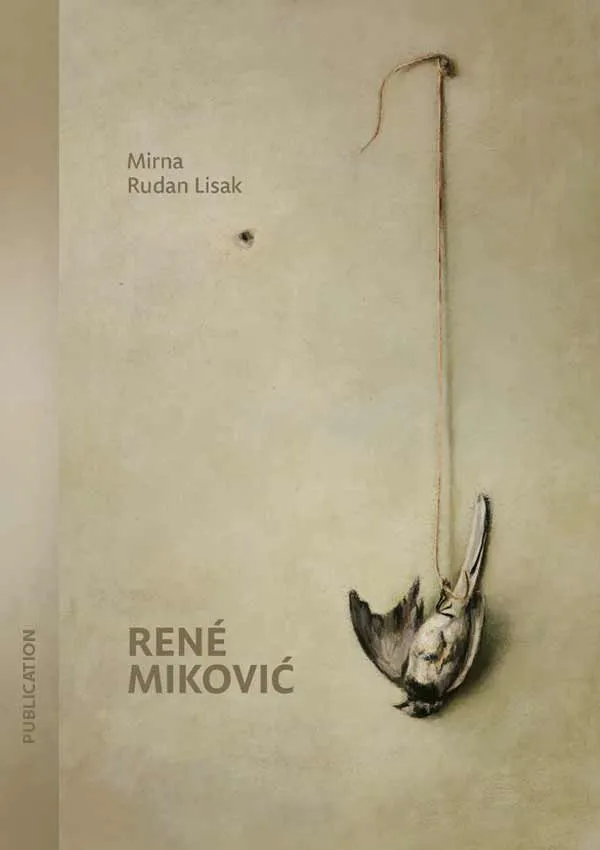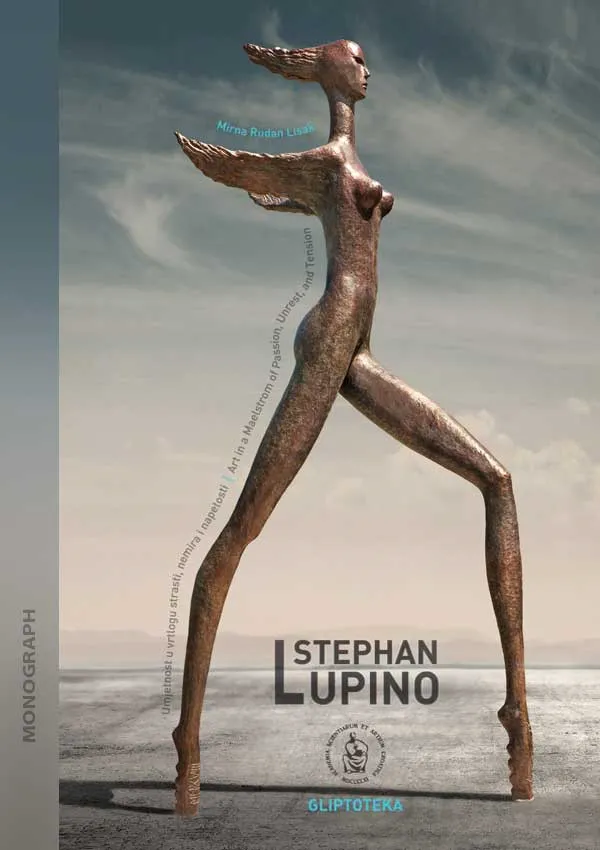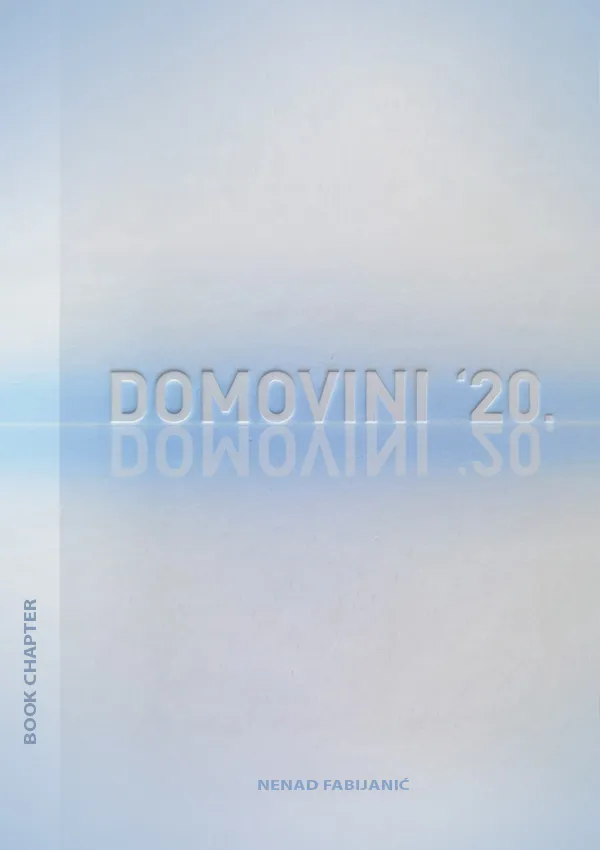Books
Books and book chapters published
by Matrix Croatica, CASA & NMMU
FEATURED BOOK
Abstract Reproductive as Productive Art
Chromatic fantasies of the composer Alexander Scriabin, painter Alexej Jawlensky, and pianist Ivo Pogorelich
MATRIX CROATICA, SISAK, 2015
— SCROLL TO READ —
Collection of essays on culture and arts in which the author, on the example of the chromatic fantasies of the composer Alexander Scriabin, painter Alexej Jawlensky and pianist Ivo Pogorelich, answers to the question of whether and when reproductive art could be considered as productive art. Abstract reproductive art is a novelty in art terminology—it is an artistic reproduction that renders the original work completely unrecognizable, despite being completely unchanged.
Editor: Andrija Tunjić, publisher: Matica hrvatska Sisak. The book is available in the Zagreb City Libraries and the Library of Croatian Academy of Sciences and Arts. It is featured on the official website of Alexej von Jawlensky Archiv S.A. (Switzerland) and official website of the legendary pianist Ivo Pogorelich. It is kept in the Memorial Museum of A. N. Scriabin in Moscow (Russia). It will be equally interesting to experts and a wider circle of readers who cultivate interest in reproductive art as a space for the interpretation of already existing art works. It can serve as a stronghold for other artists, theorists and researchers from the same field.
— SCROLL TO READ —
“This kind of commitment to professional work I classify as one of the highest ethical values.”
– IVO POGORELICH
“With her book, Mirna Rudan Lisak raises a number of questions about the relationship between productive and reproductive art. In addition, she gives excellent examples that turn everything upside down, without actually breaking the order. Reader necessarily asks himself the eternal question: chicken or egg?”
– PROF. ZLATKO KAUZLARIĆ ATAČ, REVIEWER
“I am glad that someone in Croatia explores complicated and difficult to understand connections between color and sound. Thus I think that the exhibition of Josef and Anni Albers, organized to mark the 100th anniversary of the founding of Bauhaus, creates a perfect framework for Mirna Rudan Lisak’s lecture.”
– SNJEŽANA PINTARIĆ, PHD—DIRECTOR OF THE MUSEUM OF CONTEMPORARY ART ZAGREB
“Reading Mirna Rudan Lisak’s book, I enjoyed perfectly polished sentences that are contemplative like haiku poetry.”
– JURA GAŠPARAC FOR THE CROATIAN NATIONAL TV
— SCROLL TO READ —
INTRODUCTION
Interpretation as an inner necessity of art works
Two modern productive artists and a contemporary reproductive one—at first glance there do not seem to be any common characteristics in the work of the composer Alexander Scriabin, painter Alexej Jawlensky and pianist Ivo Pogorelich. However, when the chosen subject matter is approached in a multidisciplinary fashion, perception is no longer conditioned by a single absolute focus and all perspectives suddenly open up offering many possibilities where new relations and connections are not only the result of observation but of imagination as well. That’s the moment when the past, the present and the future intermingle and no obstacles stand in the way of synthesizing diverse epochs and branches of art undertaken to establish an analytical counterpoint among the three seemingly independent but nevertheless deeply connected essays, aiming to identify contemporary tendencies in art in order to find the answer to the question as to whether and when the reproductive art may be regarded as productive.
It is, in actuality, the reproductive art that acts as the link between the three apparently unrelated artists: Scriabin and Jawlensky lived and worked at the end of the 19th and in the early 20th century, and Pogorelich is our contemporary. To be more specific, Scriabin, the composer, was in fact a trained pianist, i.e. a reproductive artist, who invested all his energy into creating productive works of art, painter Jawlensky evolved his productive art, almost as a paradox, according to the concepts of reproductive art practice, and pianist Ivo Pogorelich never expressed a desire to leave the boundaries of reproductive art even though in his suggestive interpretations of original art works he strives to raise his performance to the heights of the productive art.
By pinpointing the connections between their artistic achievements it was possible to arrive at a synthesis of the modern productive and contemporary reproductive art practices instigating a dialogue between the two avenues of art—painting and music. By way of using innovative analogies it was possible to study the reproductive art from three independent perspectives, which I found necessary because I had observed that the writings of theoreticians and philosophers have so far primarily been focused on the productive and very little or not at all on the reproductive art. Even though a few authors have offered some discussion on the subject of the performing arts, the very limited extent of this writing gives the impression that the reproductive arts are regarded as less important and less valid form of art and are therefore not a topic deserving as thorough and comprehensive investigation as the productive art.
It is more an exception than a rule to find Theodor W. Adorno and Hans Sedlmayr touching in their theoretical and philosophical writings upon the problems of interpretation of art works. Equally untypical is Walter Benjamin writing about art in the era of technical reproduction, Boris Groys astutely noting that a copy can become an original, and Jean Baudrillard turning to the world of simulation and simulacrum. A rare example of a reproductive artist writing essays on reproductive art is the violinist Rudolf Kolisch whose manuscripts are stored in the Harvard University Library. Thus my intention in writing this collection of essays was to try to fill the vacancies in the relevant literature and to respond to some of the current controversies of opinion.
…
— SCROLL TO READ —
René Miković
Halucinantne melankolije – izložba i publikacija
NACIONALNI MUZEJ MODERNE
UMJETNOSTI, 2023.
René Miković, zagrebački likovni umjetnik koji je studirao, živio i radio u Nizozemskoj, kao da je nakon prerane smrti zaboravljen, samo da bi nakon više od četvrt stoljeća ponovno bio otkriven. Pa ipak, u trenutku kad su gotovo sve teme već obrađene na bezbroj načina, rijetkost je pronaći djelo čija relevantnost polaže ispit vremena, iako je malo ili nimalo poznato ne samo domaćoj publici nego i profesionalcima kojima je obrađivanje i valoriziranje hrvatske umjetnosti svakodnevicom. Ono poziva na izvorni uvid i originalnu interpretaciju, čime utjelovljuje jedva dostižni ideal suvremenih istraživača, ali i ustanova posvećenih zaštiti, očuvanju i promicanju nacionalne kulturne baštine. Tako prva Mikovićeva samostalna izložba, osim što u Galeriji Josip Račić posthumno predstavlja njegovo sve do danas posve neistraženo djelo, postaje trajnim doprinosom hrvatskoj kulturi i umjetnosti jer kao polazišna točka može poslužiti budućim interpretacijama Mikovićeva nevelikog, ali iznimno zanimljivog i moćnog opusa.
Urednici: Branko Franceschi i Mirna Rudan Lisak, izdavač: Nacionalni muzej moderne umjetnosti. Knjiga će podjednako biti zanimljiva stručnjacima i širem krugu čitateljstva koje gaji interes za interpretacije umjetničkih djela, a kao uporište može poslužiti drugim istraživačima i interpretima Mikovićeva djela.
— SCROLL TO READ —
SAŽETAK
Halucinantne melankolije
Rene Miković…
— SCROLL TO READ —
Stephan Lupino
Art in a Maelstrom of Passion, Unrest, and Tension
CROATIAN ACADEMY OF SCIENCES AND ARTS, 2021
From July 8 to August 20, 2021, the Glyptotheque of the Croatian Academy of Sciences and Arts hosted an exhibition of sculptures, paintings and photographs by Stephan Lupino—a Croatian artist internationally recognized for his New York photography in the 1980s. Afterwords, the exhibition was hosted in Sisak, Vukovar, Osijek and other Croatian cities. The author of the exhibition and monograph (published both in Croatian and English) is Mirna Rudan Lisak.
Editor-in-Chief: Đuro Seder, Fellow of the Croatian Academy of Sciences and Arts; publisher: Croatian Academy of Sciences and Arts. The book is available in the Gliptotheque and the Library of Croatian Academy of Sciences and Arts. It will be equally interesting to experts and a wider circle of readers who have an interest in interpretations of artworks, and it can serve as a reference point for other researchers and interpreters of Lupino’s artistic creations.
— SCROLL TO READ —
”No one plunged into the depth and core of my art like Mirna Rudan Lisak. Sometimes she saw more than even me, which gave my work a new dimension and interpretation. Because of Mirna’s views, I renamed my entire series titled Lady Corona to Ondine, realizing that she really resembles the famous water nymph from European mythology, that was interpreted by many great artists.”
– STEPHAN LUPINO
”With her interpretations of artworks, Mirna Rudan Lisak once again managed to combine the incompatible: this time she united Lupino’s art with the literature of the French surrealists and their most prominent representative, Comte de Lautréamont, as well as Wagner’s and Ravel’s music”
– JURA GAŠPARAC FOR THE CROATIAN NATIONAL TV
— SCROLL TO READ —
SUMMARY
Apocalypse on the trail of dystopian surrealism
Stephan Lupino is a Croatian artist internationally renowned for his New York photography in the 1980s. Along with these photographs, his brilliant portraits, nudes, and fashion photographs have been published in prestigious global magazines such as Photo, Zoom, Vogue, King, Max, Playboy, L’Europeo, L’Espresso, Per Lui, and many others. It is impossible not to be impressed by the constellation of celebrities Lupino portrayed in his studio, such as Billy Idol, Bryan Ferry, members of The Ramones, Frank Zappa, Malcolm McLaren, Grace Jones, Pelé, Joe Strummer, Rupert Everett, Terence Stamp, Malcolm Forbes, and many others. However, from his earliest days, Lupino has also been drawn to the idea of a woman who is strong and emancipated, yet wandering and unearthly. His artistic eye turned her female enigma into a mythical creature that he, unlike Picasso, had no intention to destroy. On the contrary, woman remains an ideal he puts on a pedestal, where she continues to shine in his vast body of work.
Lupino’s works are consistent bearers of turning points on a large scale. After the New York period, where he dedicated his work to the exciting underground art and nightclub scene, he returned to Croatia at the beginning of the Croatian War of Independence. During this time, he created the photographic cycle My Angels, in which he portrayed seriously ill children as a metaphor of dying, sadness, and disappearance. Thereafter, he further developed his art — abandoning photography to focus on sculpture and painting — believing that he could express something more powerful by reflecting the experience gained in the multicultural environment of world metropolises. By mixing up different arts and media, Lupino created a peculiar artistic expression and, venturing into new forms, his own artistic direction, Lupinizam, emerged, bearing a strong stamp of his personality.
Lupinizam is by no means an exercise in vanity. It is the individual style of an artist who bravely walks the contemporary world alone — a world long devoid of any kind of style around which, as in the past, all branches of art could organize their expression. In the 20th century, the modernity finally turned its back on the traditional practice of categorisation of stylistic concepts into movements over time. This foreshadowed the impending emptiness of the postmodern age, whose vast environment gave the artist absolute freedom but also became his greatest curse because he was left with nothing to cling to. Furthermore, given that only the most powerful personalities are able to fill this boundless vacant space, perhaps the only possible, and often the only correct way of looking at art today, is to attach it to the names of the artists who are its creators.
Lupino constantly jumps off the rails in his eternal frenzy to live several lives at once. Along the way, he continuously surprises with his innovations and creations, providing answers to the world we live in. For the last fifteen years, he has replaced the camera with a chainsaw, hammer, chisel, grinder, massive old oak wood, iron, bronze, stone slabs, and other robust materials, to take his first step out of photography into the design of unique furniture. Especially noteworthy are the monumental chair-thrones dedicated to rulers like Julius Caesar and Cleopatra, King Arthur, Napoleon Bonaparte, Ban Josip Jelačić, George Washington, Queen Elizabeth, Tito, Mao Zedong, and Vladimir Putin. At the same time, Lupino does not fail to remind us of the absolute justice of God — by which the same fate awaits both king and beggar — and we remain completely aware not only of our own mortality but also of the transience of all cultures, which are, from their inception, condemned to the irrevocable ruin of their civilizations.
However, Lupino’s works are more than mere vibrations of the historical and current resonances of time. As an artist deeply in touch with reality, he boldly heralds a world yet to come in a series of thematically related cycles titled The Fifth Element, Another World, The Apocalyptic World, and The Cataclysm, where, despite the gloomy reality, he sees expressiveness and beauty, even when he speaks — in visual terms — of an apocalypse in the wake of dystopian surrealism in which the eternal struggle between good and evil takes place. At the same time, he believes that the evil that man has inflicted on the world cannot be dispelled. Thus, many of his slender sculptures — such as Predator, Bat Woman, Marilyn Monroe, Snake Woman, Fire Woman, Aphrodite, or Hermaphrodite — are the very personification of wickedness, whose power is fuelled in the darkest corners of the artist’s imagination. These works anticipate the future: They are shaped in wood and metal and painted on relief canvases filled with disturbing figures, anatomically similar to humans and placed in a surreal and post-apocalyptic environment. Their feelings are completely devoid of hatred, but there is no love in them either, so despite their latent eros, together they emanate distance, alienation, and loneliness. From these works emerged Lupino’s special world that oozes an atmosphere of anxiety and mystery: His art balances the dualities of Eros and Thanatos, despair and hope, the conscious and the subconscious, the constant and the changeable, the real and the imaginary, truth and delusion. It is precisely this unusual Lautréamontian ambivalence that has made it possible to place Lupino’s opus in space and time. Consequently, the exhibition at the Glyptotheque of the Croatian Academy of Sciences and Arts produced unexpected analogies not only with other artists from completely different artistic branches and media but also from several completely different epochs, thus shedding new and original light on his creative work.
These are “spiritual overflights that disturb the dreams of kindred spirits,” and in this maelstrom — which in the artist’s eyes turned the ocean into the realm of the prince of darkness — Lupino, like the French Surrealists, renounced antiquity as too beautiful, too perfect, and thus completely devoid of life; the life he has felt and lived in its fullness. Even when he interprets antiquity, the forms in his works do not follow any canon of beauty and are free to emanate inner tension. On this path, his dynamic silhouettes belong equally to the aerial and underwater worlds as he transforms them into mythological-allegorical motifs that — as in The Agony of the Angel or the mythical Ondine — are often falling instead of rising. This authentic European mythology is the source of the medieval aesthetics seen in Lupino’s archaic-futuristic monumental works, made of weighty, masculine materials: His robust crosses radiate chivalry, while all his iron-chained furniture is created primarily for the artist’s inner castle, where a broken mirror, in the shape of a crown witness, offers countless perspectives on the pervasive Eros, permanently embedded in the core of Lupino’s entire work. Yet, he sometimes moves in the opposite direction too, creating elongated sculptures that resemble Early Gothic works, hovering above ground and tiptoeing like ballerinas, painfully aware that man will always throw only angels to the demons. It is this eternal clash of heaven and hell that will give birth to the Angel of Fire, while the ancient Venus, born of the sea, will receive wings to finally escape the ocean by flying into the expanse of celestial blue.
Numerous wooden sculptures created in the same period display applied metal parts and are usually dedicated to a woman who is a true knightess, because Lupino is shrewd enough to know that the world was created primarily for male conquests, while women are left to conquer the conqueror. Perhaps this is the reason why his abstracted sculptures are always in battle armour, which simultaneously protects the complexity of the female being. In addition, on his artistic journey he creates a synthesis of air, water, earth, and fire, bringing us back to primordial elements amidst the coronavirus pandemic, and on the brink of coming out of this global crisis, he again turns to woman as a symbol of hope and love. Thus, in today’s world, where Lupino sees no true love other than unconditional maternal love, he shapes sculptures such as Nurturing Mother, Madonna and Child, and Olive Woman, showing that we can never escape our subconscious, which always — no matter how old we are — keeps us in our mother’s lap. However, since artists are by nature powerful agents of spirituality, the motif of the mother also brings Lupino back to sacred themes. One of them, The Last Supper, flickers on a large canvas that shapes the King of Heaven and his twelve apostles with the colour of the sea and the underwater refraction of light, giving the ocean back to primordial goodness.
There have been very few artists like Stephan Lupino, for whom every choice has always been a matter of life and death. This trait, typical of anyone who shuns mediocrity in life or work, is precisely the reason why the excitement generated by his art is analogous to the unpredictability of his life. Above all, it took courage to repeatedly fling himself from the top of the world to its very depths, so that after falling down he could once again stand up. Lupinizam, therefore, attacks the audience just like the waves of a mighty ocean, where each of its creative acts devours the previous one, hiding it in the deepest corners of its dark interior only to bring to light something completely new and unexpected, and made, in essence, of phosphorus foam and the celebration of life in all its magnificence. This style is not a style at all, because if it were still an aesthetic principle, as in the past, the artist would lose absolute creative freedom, and the audience would be deprived of the surface dance whose irregular rhythm constantly takes twists and turns, reminding us how few artists have so boldly and consistently rejected all that they possessed before. Since Lupinizam emerged precisely from the artist’s life, one thing is certain: Lupino will never be stranded on his artistic journey, and this is why, after his great success at the Glyptotheque of the Croatian Academy of Sciences and Arts, we can expect him to deliver many more creative and artistic surprises in the future.
— SCROLL TO READ —
To the Homeland ’20
Chapter: Antiquity in the foundation of Western thought—Fabijanić’s return to the source
CROATIAN ACADEMY OF SCIENCES AND ARTS, 2021
Monograph To the Homeland ’20 gives a chronology from the initial idea to the realization of the Homeland Monument, which was authored by architect Nenad Fabijanić. Snješka Knežević, Danko Plevnik, Ivo Babić, Zvonko Pađan, Mirna Rudan Lisak and Joško Belamarić are the authors of texts on the genesis, place, feature, symbolism, the journey from the people to the nation, the return to the source, the artistry, and multi-meaning of the memorial. Richly illustrated, the monograph provides a detailed account of the birth of the idea, the creation and realization of the memorial designed in the name of memory, both in pictures and words.
Editor: Nenad Fabijanić, publisher: Croatian Academy of Sciences and Arts. The book is available in the Library of Croatian Academy of Sciences and Arts, and in the Zagreb City Libraries. It will be equally interesting to experts and a wider circle of readers who are interested in the architecture of monumental and cultural heritage as a space of interpretation of Homeland, State and Sacrifice, therefore it can serve as a base for other artists, theorists and researchers in the same field.
— SCROLL TO READ —
”Fabijanić’s monument carries two messages. One is ‘in perpetuam memoriam’ (in permanent remembrance) of the difficult times of war and fallen victims, and the other is ‘memento, homo’ (remember, man) that a new free state of one people has been created and look openly to the future. The first is realized with metaphorical elements—water, air and fire, and the second with architectural artifacts—a wall and a portal, a passage to the future. Although it is possible to feel an almost Ibsenian drama in the alternation of various psychological states, the author achieved recognition of the dominant role of optimism and faith in the future, through the almost virginal purity of his forms…”
– ZVONKO PAĐAN
— SCROLL TO READ —
INTRODUCTION
Chapter: Antiquity in the foundation of Western thought—Fabijanić’s return to the source
Rare are the questions which hide such ambiguity that any, even diametrically opposite answer to them is correct—be it ”yes” or ”no”. The ambivalence of the world is reflected in such questions, and one of them is certainly: “Is antiquity a part of Western culture, therefore our culture, or is it not?” If so, how did it become a part of it and why is it considered the cradle of our civilization? It is impossible not to wonder whether during historical development at some point it is possible to turn into a completely different culture at all. Yet, despite the fact that such a case has never been recorded in the human history, we often marvel at the Middle Ages, calling it ”dark” as if it were some kind of Icarian fall, almost at the level of forgetting one’s own possibilities and achievements, rather than a completely new beginning. Never before was any birth of culture considered as dark—not even the Babylonian, Egyptian, Chinese, Indian, Mexican, classical (ancient), Arab (Islamic) or Russian culture—only the first steps of Western culture were shrouded in misunderstanding even from the very westerners, who often even today cannot understand how after the flourishing of antiquity it was possible to wallow in the ”darkness” of unconsciousness—the darkness from which the fear of death, at the moment when the soul of the new culture is still awakening, will create its original symbol as an expression of one’s own experience of the world. For antiquity, this primal symbol was a self-enclosed body, while for Western culture it was the complete opposite—a boundless, infinite space.
…
New book to be published soon!
Collection of essays in which I explore relations between architecture, literature and music, thus I hope it will surprise with some new and unexpected analogies that are an inevitable part of my researches in which I test whether development processes, theoretical concepts and instruments of one branch of art can be applied to entirely different field of art



